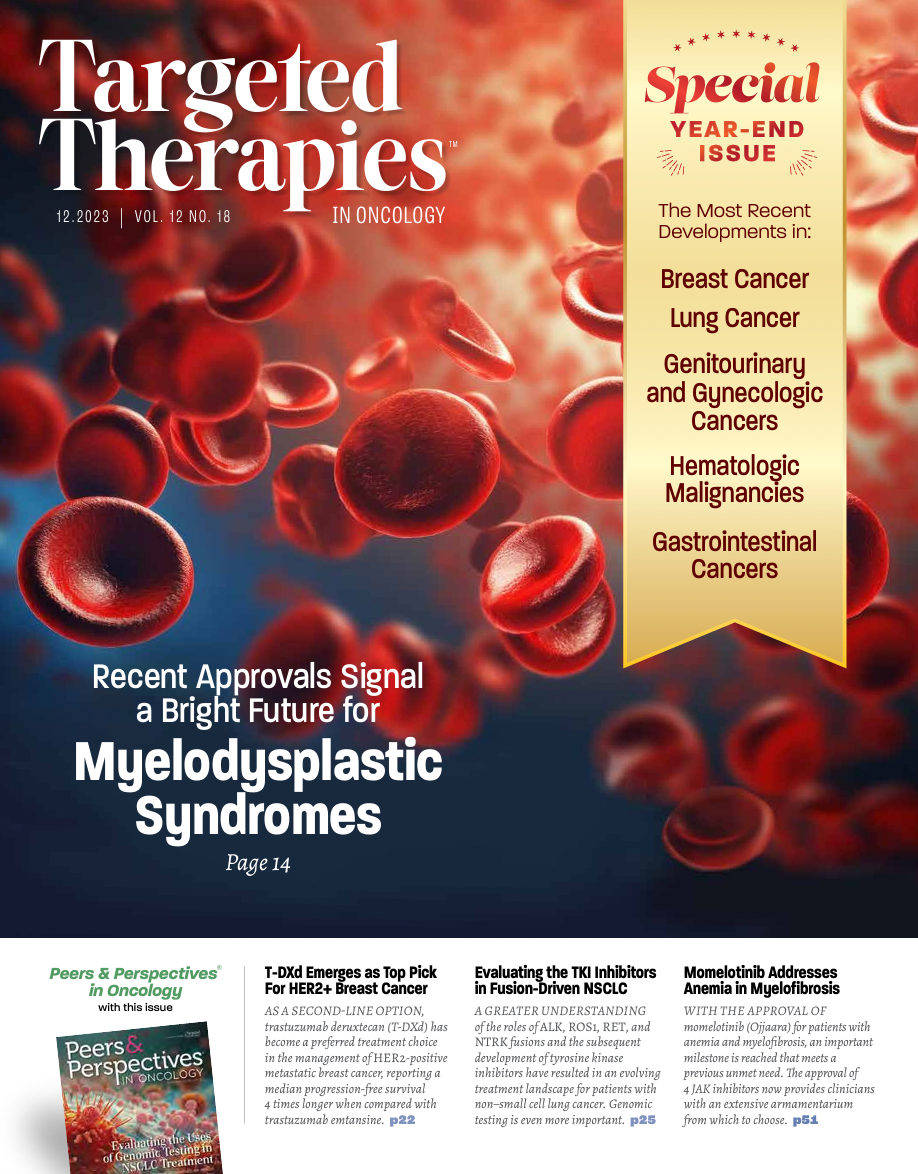Adding Brentuximab Vedotin Nearly Triples PFS in T-Cell Lymphoma
The ECHELON-2 study compared brentuximab vedotin plus cyclophosphamide, doxorubicin, and prednisone chemotherapy with the standard-of-care cyclophosphamide, doxorubicin, vincristine, and prednisone regimen for CD30- positive T-cell lymphoma.
Lymphoma cells

Adding brentuximab vedotin (Adcetris) to the cyclophosphamide, doxorubicin, and prednisone (CHP) chemotherapy regimen almost tripled progression-free survival (PFS) rates, according to findings from the ECHELON-2 study (NCT01777152). Compared with the control group, in the 5-year results, the treatment arm exhibited significantly improved PFS rates of 51.4% (95% CI, 42.8%-59.4%) vs 43.0% (95% CI, 35.8%-50.0%). This pivotal study compared the regimen with the standard-of-care cyclophosphamide, doxorubicin, vincristine (Oncovin), and prednisone (CHOP) regimen for CD30-positive T-cell lymphoma. The findings were presented by Steven M. Horwitz, MD, at the 41st Annual Chemotherapy Foundation Symposium Innovative Cancer Therapy for Tomorrow conference held on November 8 to 10, 2023 in New York.1
“The classifications of T-cell lymphomas have become much more complex. Our understanding of the biology and ability to describe different subtypes has significantly increased our therapeutic options,” Horwitz said. “In the latest International T-cell [Lymphoma] Project classification, similar to the World Health Organization classification, there are [more than] 30 different entities. This increased understanding reflects advancements in our knowledge of the biology of different T-cell lymphomas. We are striving to catch up therapeutically. Advancements have been seen in the areas of follicular helper T-cell lymphoma.” Horwitz is a medical oncologist at Memorial Sloan Kettering Cancer Center in New York, New York, specializing in cutaneous T-cell lymphoma, lymphoma, and Hodgkin and non-Hodgkin lymphoma.
The 5-year results of the double-blind ECHELON-2 study included 452 untreated patients with CD30-positive T-cell lymphoma, including those with ALK-negative anaplastic large cell lymphoma (ALCL), encompassing a higher-risk population with International Prognostic Index risk factors of 2 or greater. Other T-cell lymphoma subtypes, such as peripheral T-cell lymphoma, not otherwise specified (PTCL-NOS) or angioimmunoblastic T-cell lymphoma (AITL), required eligible patients to have 10% CD30 expression on their tumor cells.2
Patients were randomly assigned 1:1 to receive either brentuximab vedotin plus CHP and placebo vincristine or CHOP plus placebo and brentuximab vedotin, with PFS as the primary end point. The overall survival (OS) in the 5-year updates, was also more favorable in the experimental arm, reporting an HR of 0.72 and an OS rate of 70.1% (95% CI, 63.3%-75.9%) compared with 61.0% (95% CI, 54.0%-67.3%) in the control arm. Both the OS and PFS rates were generally consistent between subgroups.
Certain mutations, such as the TP53 mutation observed in the PTCL-NOS population, have shown lower chances of long-term benefit from combination chemotherapy. CDKN2A also exhibits less benefit, whereas TP63 alterations were deemed highly resistant to chemotherapy. Conversely, the DUSP22 gene mutation has shown a more favorable response to combination chemotherapy.
“As we aim to progress, it’s crucial to remember that some patients benefit from combination chemotherapy. We aspire to build on their success while identifying those for whom this treatment proves ineffective and redirecting them toward alternate approaches,” Horwitz said.
Further discussion highlighted the diminishing effects of chemotherapy, emphasizing that “it’s evident that many patients either don’t respond [to chemotherapy] or lack long-term benefit.” For patients with ALCL who received CHOP, the PFS stands at 2 years and the median OS is not reached at 5 years. The projected improvements in PFS are estimated at 10% to 20% and are mostly beneficial for patients who are sensitive to chemotherapy, primarily within the ALCL subgroup and not beyond.
Intensifying the dose of chemotherapy and autologous transplant was also discussed; although still viable, this approach benefited certain chemo-sensitive subgroups more, such as ALK-positive ALCL, but not PTCL-NOS and AITL.
With combination chemotherapy, PFS has historically mirrored OS, providing limited salvage therapy options for patients with relapsed disease, as per data from the Swedish Lymphoma Registry.3
A nonpopulation-based phase 2 trial revealed improved 5-year results compared with those observed in the Swedish registry by adding etoposide (Vepesid) to CHOP. The intent-to-treat analysis showed a 5-year PFS rate of approximately 44% and the OS surpassed 50%.1,4
However, as understanding regarding subtype heterogeneity increases, it’s evident that the benefits of intensive chemotherapy may not uniformly apply across all subtypes.
For example, ALK-negative ALCL exhibited a PFS rate of more than 60% at 5 years, but PTCL-NOS and AITL cohorts, along with neuropathy-associated cases, declined below 40%.
Therefore, the potential benefit of intensified chemotherapy might not be uniformly distributed among these subtypes. The growing understanding emphasizes the need for tailored treatments based on subtype characteristics rather than uniform application of chemotherapy across all cases.
Future steps include further exploration of adding agents such as brentuximab vedotin and etoposide to CHOP. Horwitz also touched on alternate paths regarding epigenetic therapies, highlighting the study by Jia Ruan, MD, PhD and colleagues (NCT03542266),5 which added azacitidine to CHOP and resulted in 2-year PFS rates at 69.2% (95% CI, 46.7%-91.7%) for the group of patients with PTCL T follicular helper phenotype (PTCL-TFH).1
“When considering augmentation to a CHOP backbone, especially for CD30- targeted agents [such as] brentuximab vedotin in the untreated PTCL population, there’s an observable [OS] benefit with this combination for [ALCL],” Horwitz said.
“Although we’ve seen success with combination chemotherapy, understanding the beneficiaries and shifting nonresponders to alternative strategies is crucial. Attempts to integrate active agents into up-front therapy continue, [with the aim] to minimize toxicity. Moving forward, subtype-specific strategies, not solely based on histology but possibly molecular subtypes or other vulnerabilities, seem increasingly necessary," Horwitz concluded.1
REFERENCES:
1. Horwitz S. Updates in T-cell lymphoma. Presented at: 41st Annual Chemotherapy Foundation Symposium Innovation Cancer Therapy for Tomorrow conference; November 8-10, 2023; New York, NY.
2. Horwitz S, O’Connor OA, Pro B, et al. The ECHELON-2 Trial: 5-year results of a randomized, phase III study of brentuximab vedotin with chemotherapy for CD30-positive peripheral T-cell lymphoma. Ann Oncol. 2022;33(3):288-298. doi:10.1016/j. annonc.2021.12.002
3. Ellin F, Landström J, Jerkeman M, Relander T. Real-world data on prognostic factors and treatment in peripheral T-cell lymphomas: a study from the Swedish Lymphoma Registry. Blood. 2014;124(10):1570-1577. doi:10.1182/ blood-2014-04-573089
4. Schmitz N, Trümper L, Ziepert M, et al. Treatment and prognosis of mature T-cell and NK-cell lymphoma: an analysis of patients with T-cell lymphoma treated in studies of the German High-Grade Non-Hodgkin Lymphoma Study Group. Blood. 2010;116(18):3418-3425. doi:10.1182/blood-2010-02-270785
5. Ruan J, Moskowitz A, Mehta-Shah N, et al. Multicenter phase 2 study of oral azacitidine (CC-486) plus CHOP as initial treatment for PTCL. Blood. 2023;141(18):2194-2205. doi:10.1182/blood.2022018254

Survivorship Care Promotes Evidence-Based Approaches for Quality of Life and Beyond
March 21st 2025Frank J. Penedo, PhD, explains the challenges of survivorship care for patients with cancer and how he implements programs to support patients’ emotional, physical, and practical needs.
Read More
Examining the Non-Hodgkin Lymphoma Treatment Paradigm
July 15th 2022In season 3, episode 6 of Targeted Talks, Yazan Samhouri, MD, discusses the exciting new agents for the treatment of non-Hodgkin lymphoma, the clinical trials that support their use, and hopes for the future of treatment.
Listen